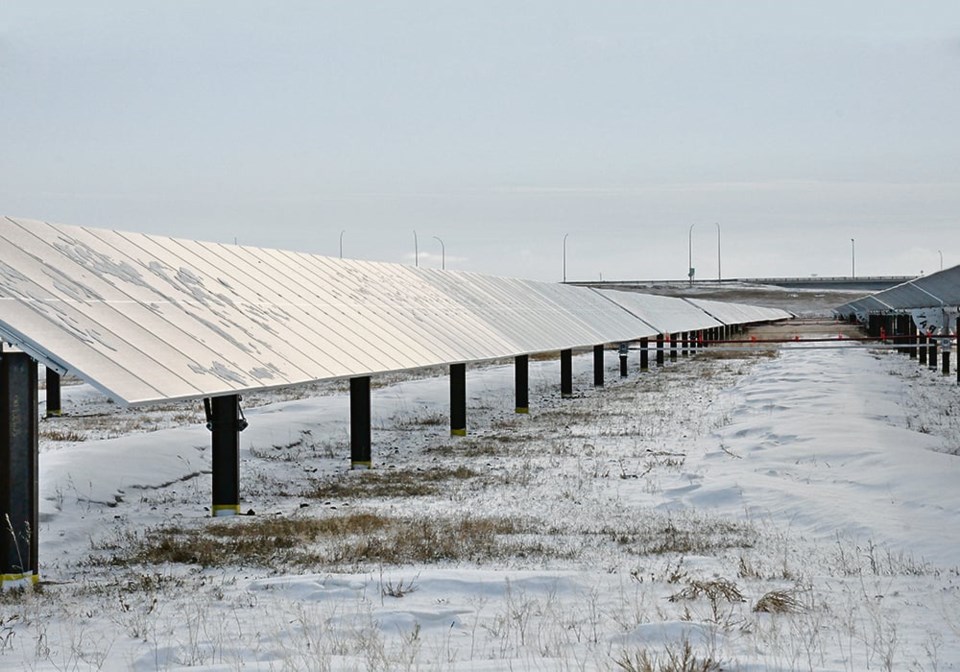WESTERN PRODUCER — An agrivoltaics research park to be built this summer in Alberta is designed to explore how beef producers can maximize profits and improve pastures by using their land for both ranching and solar power generation.
Traditional solar projects in the province allow livestock such as sheep to graze under solar panels to control weeds, said associate professor Paul Galpern of the University of Calgary’s biological sciences department.
“I am starting this conversation by saying what we’re doing is not solar panels plus animals. It is solar panels plus animals, but different.”
The university is collaborating with Solartility Inc. on the research park. The partnership received $3.1 million from Emissions Reduction Alberta, which was announced Dec. 6 at the United Nations Climate Change Conference in Dubai.
A provincial moratorium on approvals for wind and solar projects was lifted Feb. 29. It was implemented in 2023 by the Alberta government partly because a boom in renewable energy development led rural municipalities to fear the loss of prime farmland.
New rules were recently placed on wind and solar following the conclusion of public hearings and the gathering of input by the Alberta Utilities Commission. It is slated to file its final report to the provincial government by the end of March.
Agrivoltaics refers to the simultaneous use of land for both agriculture and solar power. Galpern said the agrivoltaics research park will have a smaller footprint compared to the 3,330-acre Travers Solar Project in Vulcan County, one of the largest developments of its kind in North America.
“The big argument there is Albertans don’t want to see their food producing landscapes removed with industrial facilities. Fine, I agree, but when you co-locate that — when you don’t reduce the agricultural production of that land, in this case, ranch land, but you give that farmer extra revenue, and you diversify your electrical grid while you’re doing that — there’s huge potential here.”
The research park will be located at the university’s W.A. Ranches northwest of Calgary. The working cow-calf operation contains about 19,000 acres that are used for cattle and feed production.
The agrivoltaics project will involve the university’s Faculty of Veterinary Medicine, Schulich School of Engineering and the Faculty of Science. It may use solar panels oriented vertically, like fences, rather than the usual practice of angle installation, said Galpern.
That could reduce the amount of land covered by panels, he said.
“This is the key innovation here of this approach, and this is why we think it has this potential not just to be yet another solar project in which some animals run around. This is about actually maintaining the value of that ranch pasture.”
It could provide livestock with greater freedom of movement while reducing the visual impact on the landscape, said Galpern, noting there could also be benefits for pastures.
“Of course, any tall, fat fence that’s opaque is going to cast a shadow as the sun moves across the sky, but it’s not going to be permanently in the shade, which is the key innovation here. And we think — and this is one of the things that we really want to test — that’s going to have very positive effects on forage quality.”
The remaining shade from the solar panels could also benefit plants by boosting water retention, which could improve nutritional quality and yields, said Galpern. Resulting healthy forage could inhibit weed growth.
However, there will be a tradeoff in terms of electricity generation because vertical solar panels can’t capture as much direct sunlight.
“Why would you set up an agrivoltaics facility that would have a somewhat reduced solar exposure? And the one big reason is that it’s going to make sure that the land stays productive — in other words is producing quality forage and keeping those animals moving around — and the second big one is that it’s about the quality of the electricity you generate.”
Vertical solar panels aligned north-south will be able to capture early morning and late evening sunlight at its maximum, which is when prices per kilowatt hour are highest in Alberta due to peak demand, said Galpern.
“The modelling has been done by Solartility, our industrial partner, and they’ve shown substantial potential for, if you’d like to think of it, not in terms of kilowatt hours but in terms of dollars earned. There is a high potential here to not just break even … but to do a great job in terms of the revenue.”
Peak demand is also when power plants that burn fossil fuels typically ramp up generation to ensure stability of the electrical grid during cold snaps, said Galpern. It means agrivoltaic projects that supply clean power during such periods could reduce carbon emissions.
The research park could allow scientists to study different aspects of agrivoltaics ranging from environmental impact and soil health to how well different designs resist damage from livestock, said Galpern. One particularly important question is whether it will affect sequestration or storage of carbon in pastures.
“And we know that ranchers love their land … so, we want to be able to tell them with confidence, with the scientific data, that co-locating this with their crops is good for their animals, and it’s good for their landscapes, it’s good for their fields, and good for their pastures.”




